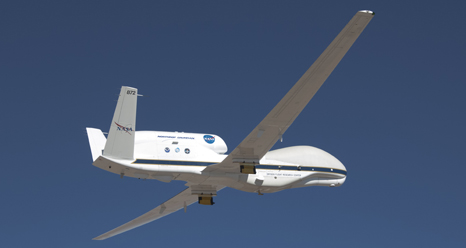
NASA’s pair of remotely operated Global Hawk Earth science aircraft marked a milestone on Oct. 23, the fifth anniversary of the first NASA flight by a Global Hawk aircraft.
That first flight on Oct. 23, 2009 was flown by NASA 872, the sixth early developmental model of the high-altitude, long-endurance RQ-4 aircraft. The RQ-4 Global Hawks were designed and built by Northrop Grumman Corp. for the Advanced Concept Technology Demonstrator program sponsored by the Defense Advanced Research Projects Agency. NASA 872 and its companion, NASA 871, were turned over to NASA by the Air Force in 2007 after the developmental flight test program was completed.
In the intervening years since the first NASA checkout flight, NASA’s two Global Hawks have made 133 flights totaling 1,644 flight hours, or an average of almost 12 ½ hours in the air on each flight. NASA 872 has made 100 of those flights, NASA 871 the remaining 33.
“NASA’s Global Hawks have accumulated a long list of amazing accomplishments during these first five years of flight operations,” commented Chris Naftel, Global Hawk project manager at NASA’s Armstrong Flight Research Center on Edwards Air Force Base, California, where the two aircraft are based. “The dedicated efforts by the NASA, Northrop Grumman, and NOAA team members have taken this military asset and transformed it into a very capable asset for long endurance high altitude Earth science research.”
NASA’s Global Hawks have been deployed to several other locations for specific missions, including Guam and most recently, NASA’s Wallops Flight Facility on Wallops Island, Virginia, for the recently concluded 2014 Hurricane and Severe Storm Sentinel science mission. Flight and science operations centers for the aircraft are located at both Armstrong and Wallops facilities. In addition, a portable ground control station has made worldwide deployments and missions possible.
NASA’s Science Mission Directorate supports NASA research activities on the aircraft. The Science Mission Directorate has teamed with the National Oceanic and Atmospheric Administration and the Department of Energy on other Earth observation research missions flown by the aircraft. NASA’s Ames Research Center at Moffett Field, California, provides significant assistance in planning and managing science missions flown by the Global Hawks.
Through a partnership with NASA Armstrong, Northrop Grumman Aerospace Systems, Rancho Bernardo, California, shares use of the ground control station and aircraft for further development and flight test activities of the military Global Hawk fleet, and provides maintenance support for the NASA Global Hawk aircraft.
For more on NASA’s use of Global Hawk aircraft for Earth science, visit:
https://www.nasa.gov/centers/armstrong/news/FactSheets/FS-098-DFRC.html
For more information about NASA’s Earth science activities in 2014, visit:
https://www.nasa.gov/earthrightnow
Author: Alan Brown, public affairs, NASA Armstrong Flight Research Center































